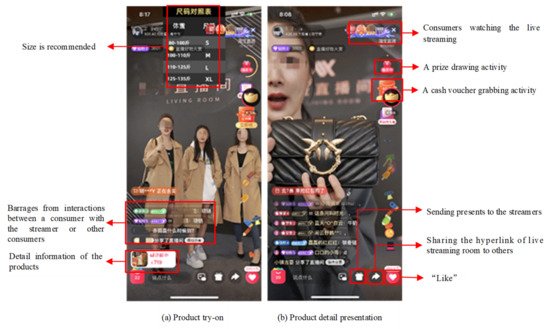You're using an outdated browser. Please upgrade to a modern browser for the best experience.
Please note this is an old version of this entry, which may differ significantly from the current revision.
Subjects:
Behavioral Sciences
As a new business model, live-streaming commerce has great commercial value. Interactivity, visualization, entertainment, and professionalization play considerable roles in consumer behavioral responses and that their psychological mechanisms are different. Male respondents are more satisfied with interactivity than females. E-commerce platforms are more interactive, visible and professional than social media platforms, and the trust mechanism of social media platforms is immature.
- live-streaming commerce
- interactivity
- visualization
- entertainment
- professionalization
1. Live-Streaming Commerce
With the rapid development of mobile communication technology, live-streaming commerce has emerged in recent years as a new business model, consisting of “live streaming + social + e-commerce”. Traditional e-commerce has been enabled by Web 1.0 technology, which allows for one-to-one interaction, while social commerce has been enabled by Web 2.0 technology, which allows for many-to-many interaction, and live-streaming commerce enabled by Web 3.0 technology, which allows for real-time multidimensional interaction [18]. Interactivity is significantly improved in live-streaming commerce [8,9]. In addition, visualization [5,13], entertainment [5,14], and professionalization [15] have been greatly improved. Some screenshots of a live streaming studio are shown in Figure 1. The streamer shows various details of his or her products to consumers by means of strategic explanations, such as try-ons. When watching live streaming, consumers can interact with the streamer, draw prizes, and grab cash vouchers.

Figure 1. Screenshots of live streaming: (a) The streamers are trying on the product. (b)The streamer is showing details of the product.
2. Stimulus–Organism–Response Framework
Under the SOR framework, an external environmental stimulus (S) impacts the internal state of a consumer (O) and subsequently influences his or her behavioral responses (R) while shopping online [8,9]. Xue applied the SOR framework to conceptualize interactivity as a stimulus, perceived usefulness, psychological distance, and perceived risk as internal states, and social commerce engagement as a response in social commerce [8]. Kang employed the SOR framework to explore the dynamic effect of interactivity on customer engagement behaviors through tie strength in live-streaming commerce platforms [9]. Therefore, the SOR framework offers a structured method for testing the impact of live peculiarities as external environmental stimuli on customer behavioral responses. In this study, social presence, psychological distance, and trust were selected to assess the internal states of consumers, and engagement and purchase intentions were selected to assess their responses. By structuring a causal relationship among stimuli, organisms, and responses, a systematic framework was provided to trace the impact of live peculiarities on purchase intentions.
2.1. Live Peculiarities as Environmental Stimuli (S)
Media richness theory regards rich information as being more capable of reducing equivocality than lean information [19]. Currently, live-streaming commerce, which provides real-time communication, text messages, voice, and video, possesses high media richness [20]. Compared with social commerce, live-streaming commerce is more interactive [8,9,21], visual [5,13], entertaining [5,14] and professional [15]. Therefore, this study adopted four live peculiarities, namely, interactivity, visualization, entertainment, and professionalization, as external stimuli.
2.2. Cognitive and Affective Factors as Inner States of the Organism (O)
The SOR framework demonstrates that the effect of environmental stimuli on customer behavioral responses is mediated through virtual experiences [8]. Trust is widely used as an internal state to impact purchase intentions in e-commerce [18,22]. Compared with traditional e-commerce, frequent interactions shorten the social distance between customers and sellers [8,9]. Social presence has been used to quantify the cognitive state of consumers in live-streaming commerce [17]. Therefore, we utilized social presence, psychological distance and trust to measure the cognitive and affective states of consumers in live-streaming commerce.
2.3. Engagement and Purchase Intentions as Behavioral Responses (R)
Engagement has been widely used in social commerce to conceptualize consumer behavioral responses [23,24,25]. In live-streaming commerce, some scholars employ engagement to describe consumer behavioral responses [5,8,9], while others employ purchase intentions [6,10,17]. In this study, both engagement and purchase intentions were employed to describe consumer behavioral responses. To explore how to choose these two dependent variables, engagement and purchase intentions, we assumed that engagement positively affects purchase intentions.
This entry is adapted from the peer-reviewed paper 10.3390/su14021045
This entry is offline, you can click here to edit this entry!
